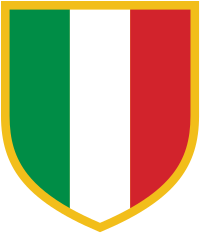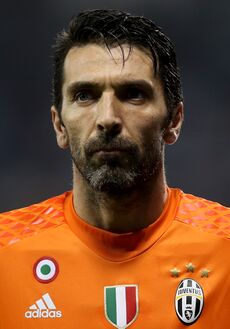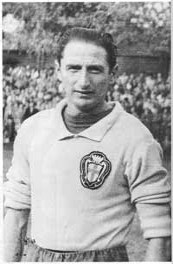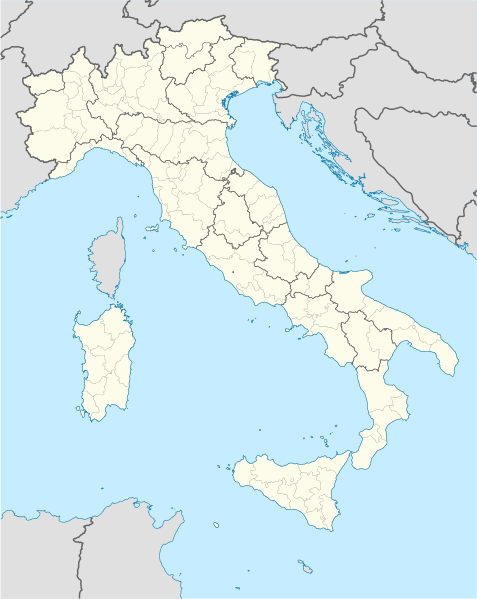الدوري الإيطالي الدرجة الأولى
 | |
| الهيئة المنظِمة | الدوري الإيطالي الوطني للمحترفين |
|---|---|
| تأسس | 1898 1929 (دورة روبن) |
| البلد | إيطاليا |
| الاتحاد | الاتحاد الأوروپي لكرة القدم |
| عدد الفرق | 20 |
| المستوى في الهرم | 1 |
| يتراجع إلى | الدوري الإيطالي الدرجة الثانية |
| الكأس المحلي | كأس إيطاليا كأس السوبر الإيطالي |
| الكأس العالمي | دوري أبطال أوروپا الدوري الأوروپي دوري المؤتمر الأوروپي |
| الأبطال الحالي | نادي إيه سي ميلان (19 لقب) (2021–22) |
| أكثر بطولات كأس | يوڤنتوس (36 لقب) |
| أكثر ظهور |
|
| الهداف | سيلفيو بيولا (274) |
| البث التلفزيوني | List of broadcasters |
| الموقع الإلكتروني | legaseriea.it |
الدوري الإيطالي الدرجة الأولى (الكالشيو)، سيريا أي (بالإيطالية: Serie A) هو مسابقة الدوري للأندية كرة القدم المحترفة تأسست عام 1898 ويقع على قمة الهرم الكروي في إيطاليا، حيث يعتبر الكالشيو دوري الدرجة الأولى في إيطاليا ويعتبر من الدوريات النخبة على مستوى العالم.
البطولة في صيغتها الحالية، يلعب كل فريق مع الآخر مرتين ذهابا وإيابا (كمجموعة واحدة) بينما النظام المتبع قديما قبل عام 1929 هو تقسيم الفرق إلى عدة مجموعات ومن ثم تجري عملية وأبطال المجموعات يتلاقون إلى أن يتم تحديد الفريق الفائز بالبطولة، ومن الجدير ذكره أن النظام القديم قد تم الغاء العمل به في موسم 1929-1930.
يلعب في الدوري الإيطالي ثلاثة من الأندية المؤسسة لمجموعة G-14 ألا وهي (يوفنتوس، إيه سي ميلان، إنتر ميلان)، أما من ناحية الجوائز الفردية فإن الأندية الإيطالية تمتلك نصيب الأسد في الفوز بجائزة الكرة الذهبية يـ 20 مرة. يعتبر إيه سي ميلان من أنجح الأندية على مستوى العالم من ناحية الفوز بالألقاب الدولية والقارية بـ 18 لقب، بالمقابل فإن يوفنتوس هو أنجح الفرق الإيطالية برصيد 42 لقب محلي. ومن جهة أخرى، فإن إنتر ميلان هو الفريق الذي حقق الثلاثية التارخية في موسم 2009-2010.
تاريخيا تعتبر الاندية الإيطالية الأكثر وصولا للنهائيات والأكثر احرازا للألقاب الأوروبية بواقع 36 بطولة أوروبية مقسمة كالتالي: دوري أبطال أوروبا 12 لقب ،كأس الإتحاد الأوروبي 9 القاب ،كأس السوبر الأوروبي 9 القاب ،كأس أبطال الكؤوس 7 ألقاب. ولنادي إيه سي ميلان حصة الأسد منها بواقع 14 لقب. حاليا، يحتل الدوري الإيطالي المركز الرابع بين الدوريات الأوروبية اعتماداً على نتائج أنديتها في البطولات الأوروبية، والخامس بالنسبة لمركز IFFHS للإحصاءات كرة القدم.
الدوري الإيطالي لكرة القدم هو أحد أكثر بطولات كرة القدم شهرة في العالم. من بين أعظم 100 لاعب كرة قدم في التاريخ تم اختيارهم من قبل مجلة FourFourTwo في عام 2017، شارك 42 لاعباً في دوري الدرجة الأولى الإيطالي، أكثر من أي دوري آخر في العالم.[1] يوڤنتوس هو الفريق الذي أنتج أكبر عدد من أبطال كأس العالم (25)، مع إإنتر ميلانو (19) وروما (15) وميلان (10)، في المركز الثالث على التوالي والرابع والتاسع في هذا الترتيب.[2]
تاريخ الكالتشيو
Serie A, as it is structured today, began during the 1929–30 season. From 1898 to 1922, the competition was organised into regional groups. Because of ever growing teams attending regional championships, the Italian Football Federation (FIGC) split the CCI (Italian Football Confederation) in 1921, which founded in Milan the Lega Nord (Northern Football League), ancestor of present-day Lega Serie A. When CCI teams rejoined the FIGC created two interregional divisions renaming Categories into Divisions and splitting FIGC sections into two north–south leagues. In 1926, due to internal crises and fascist pressures, the FIGC changed internal settings, adding southern teams to the national division, ultimately leading to the 1929–30 final settlement. Torino were declared champions in the 1948–49 season following a plane crash near the end of the season in which the entire team was killed.[بحاجة لمصدر]
نظام الكالتشيو
بالنسبة لتاريخ الدوري الإيطالي الدرجة الأولى، تنافس 16 أو 18 نادياً على المستوى الأعلى. منذ 2004–05، كان هناك 20 نادياً في المجموع. في موسم (1947-1948) لعب مع 21 فريق لأسباب سياسية، بعد توترات ما بعد الحرب مع يوغسلاڤيا. يوجد أدناه سجل كامل لعدد الفرق التي لعبت في كل موسم طوال تاريخ الدوري ؛
- 18 نادي: 1929–1934
- 16 نادي: 1934–1943
- 20 نادي: 1946–1947
- 21 نادي: 1947–1948
- 20 نادي: 1948–1952
- 18 نادي: 1952–1967
- 16 نادي: 1967–1988
- 18 نادي: 1988–2004
- 20 نادي: 2004–الحاضر

خلال الموسم الذي يمتد من أغسطس إلى مايو، يلعب كل فريق مرتين مع كل فريق آخر. مرة واحدة في على أرض ملعبه ومرة واحدة خارج الأرض، بإجمالي 38 مباراة لكل فريق بنهاية الموسم. وهكذا، في كرة القدم الإيطالية، يتم استخدام تنسيق حقيقي جولة روبن. في النصف الأول من الموسم، المسمى بـ أنداتا (الذهاب)، يلعب كل فريق مرة واحدة ضد كل خصم في الدوري، ليصبح المجموع 19 مباراة. في النصف الثاني من الموسم، المسمى بـ رتورنو (الإياب)، يلعب الفريقان 19 مباراة أخرى، مرة أخرى ضد كل منافس، يتم فيها عكس المباريات على أرضه وفي الذهاب. كان لنصفي الموسم نفس الترتيب تماماً من المباريات حتى 2021–22 Season، عندما تم تقديم تقويم غير متماثل، باتباع تنسيق الدوري الإنگليزي الممتاز والإسپاني و الفرنسي.[3]منذ موسم 1994-1995، يتم منح الفرق ثلاث نقاط للفوز ونقطة واحدة للتعادل ولا نقاط للخسارة. قبل ذلك، تم منح الفرق نقطتين للفوز، واحدة للتعادل ولا شيء للخسارة. و تهبط الفرق الثلاثة الأقل ترتيباً في نهاية الموسم إلى دوري الدرجة الثانية، ويتم ترقية ثلاثة فرق من دوري الدرجة الثانية لتحل محلهم في الموسم المقبل.
التصفيات الأوروپية
اعتباراً من عام 2022، تم تصنيف الدوري الإيطالي باعتباره رابع أفضل دوري من خلال معامل الاتحاد الأوروپي لكرة القدم، وبالتالي فإن الفرق الأربعة الأولى في الدوري الإيطالي تتأهل مباشرة إلى دوري أبطال أوروپا مرحلة المجموعات. الفريق الذي يحتل المركز الخامس، جنباً إلى جنب مع الفائز بكأس إيطاليا (إذا انتهى الفائز بكأس إيطاليا خارج المراكز الخمسة الأولى) أو احتل الفريق المركز السادس (إذا انتهى الفائز بكأس إيطاليا داخل المراكز الخمسة الأولى)، يتأهل إلى الدوري الأوروپي مرحلة المجموعات. النادي المصنف السادس أو السابع، اعتماداً على أداء الدوري للفائز بكأس إيطاليا، ينضم إلى الجولة التأهيلية النهائية من دوري المؤتمر الأوروپي.
كسر التعادل
إذا كان هناك فريقان متعادلان بالنقاط للمركز الأول بعد كل المباريات الـ 38، فإن الفريق الذي يفوز بالسكوديتو يتم تحديده من خلال مباراة فاصلة من رجل واحد لمدة 90 دقيقة وركلات الترجيح (لا يوجد وقت إضافي)، على أن تقام على ملعب محايدة.[4] إذا تم تعادل أكثر من فريقين في أحد تلك المواقع، فسيتم تحديد الفريقين اللذين سيلعبان في المباراة من خلال جدول صغير بين الفريقين المعنيين. بالنسبة للترابط في أي وضع آخر، يكون كسر التعادل الحاسم كما يلي:
- Head-to-head points
- Goal difference of head-to-head games
- Goal difference overall
- Higher number of goals scored
- Play-off game at a neutral venue if relevant to decide European spot or relegation; otherwise by draw[5]
Prior to 2005–06 a play-off would immediately be used if teams were tied in a championship, European qualification, or relegation spot, but between 2006–07 and 2021–22 the tiebreakers currently used for all places besides first were in place to decide the scudetto winner, though this was never needed. In some past years, the playoff was a single game at a neutral site while in others it was a two-legged tie decided by aggregate score. A playoff game has never been needed since the tiebreaking format changed.
The only time a playoff was used to decide the champion occurred in the 1963–64 season when Bologna and Inter both finished on 54 points. Bologna won the playoff 2–0 at the Stadio Olimpico in Rome to win the scudetto.[5] Playoff games have been used on multiple occasions to decide European competition qualifications (most recently in 1999–2000) and relegation (most recently in 2004–05).
نظام التأهل و الهبوط
الأندية
Prior to 1929, many clubs competed in the top level of Italian football as the earlier rounds were competed up to 1922 on a regional basis then interregional up to 1929. Below is a list of Serie A clubs who have competed in the competition since it has been a league format (66 in total).
موسم 2022–23
الأندية
The following 20 clubs are competing in the Serie A during the 2022–23 season.
| الفريق | الموقع | 2021–22 season | First season in Serie A (as round-robin) | No. of Serie A seasons (as round r.) | First season of current spell | No. of seasons of current spell | Serie A titles (as round r.) | National titles | Most recent title |
|---|---|---|---|---|---|---|---|---|---|
| Atalanta | Bergamo | 8th in Serie A | 1937–38 | 62 | 2011–12 | 12 | 0 | 0 | – |
| Bologna | Bologna | 13th in Serie A | 1929–30 | 76 | 2015–16 | 8 | 5 | 7 | 1963–64 |
| Cremonese | Cremona | 2nd in Serie B | 1929–30 | 8 | 2022–23 | 1 | 0 | 0 | – |
| Empoli | Empoli | 15th Serie A | 1986–87 | 15 | 2021–22 | 2 | 0 | 0 | – |
| Fiorentina | Florence | 7th in Serie A | 1931–32 | 85 | 2004–05 | 19 | 2 | 2 | 1968–69 |
| Hellas Verona | Verona | 9th in Serie A | 1957–58 | 32 | 2019–20 | 4 | 1 | 1 | 1984–85 |
| Inter Milan | Milan | 2nd in Serie A | 1929–30 | 91 | 1929–30 | 91 | 17 | 19 | 2020–21 |
| Juventus | Turin | 4th in Serie A | 1929–30 | 90 | 2007–08 | 16 | 34 | 36 | 2019–20 |
| Lazio | Rome | 5th in Serie A | 1929–30 | 80 | 1988–89 | 35 | 2 | 2 | 1999–00 |
| Lecce | Lecce | Serie B winner | 1985–86 | 17 | 2022–23 | 1 | 0 | 0 | – |
| AC Milan | Milan | Champion of Italy | 1929–30 | 89 | 1983–84 | 40 | 16 | 19 | 2021–22 |
| Monza | Monza | Serie B play-off winners | 2022–23 | 1 | 2022–23 | 1 | 0 | 0 | – |
| Napoli | Naples | 3rd in Serie A | 1929–30 | 77 | 2007–08 | 16 | 2 | 2 | 1989–90 |
| Roma | Rome | 6th in Serie A | 1929–30 | 90 | 1952–53 | 71 | 3 | 3 | 2000–01 |
| Salernitana | Salerno | 17th in Serie A | 1947–48 | 4 | 2021–22 | 2 | 0 | 0 | – |
| Sampdoria | Genoa | 15th in Serie A | 1934–35 | 74 | 2012–13 | 11 | 1 | 1 | 1990–91 |
| Sassuolo | Sassuolo | 11th in Serie A | 2013–14 | 10 | 2013–14 | 10 | 0 | 0 | – |
| Spezia | La Spezia | 16th in Serie A | 2020–21 | 3 | 2020–21 | 3 | 0 | 0 | – |
| Torino | Turin | 10th in Serie A | 1929–30 | 79 | 2012–13 | 11 | 5 | 7 | 1975–76 |
| Udinese | Udine | 12th in Serie A | 1950–51 | 50 | 1995–96 | 28 | 0 | 0 | – |
Maps
Seasons in Serie A
There are 68 teams that have taken part in 91 Serie A championships in a single round that was played from the 1929–30 season until the 2022–23 season. The teams in bold compete in Serie A currently. Inter Milan is the only team that has played Serie A football in every season.
- 91 seasons: Inter Milan
- 90 seasons: Juventus, Roma
- 89 seasons: AC Milan
- 85 seasons: Fiorentina
- 80 seasons: Lazio
- 79 seasons: Torino
- 77 seasons: Napoli
- 76 seasons: Bologna
- 66 seasons: Sampdoria[6]
- 62 seasons: Atalanta
- 55 seasons: Genoa
- 50 seasons: Udinese
- 42 seasons: Cagliari
- 32 seasons: Hellas Verona
- 30 seasons: Bari, Vicenza
- 29 seasons: Palermo
- 27 seasons: Parma
- 26 seasons: Triestina
- 23 seasons: Brescia
- 19 seasons: SPAL
- 18 seasons: Livorno
- 17 seasons: Catania, Chievo, Lecce
- 16 seasons: Ascoli, Padova
- 15 seasons: Empoli
- 13 seasons: Alessandria, Cesena, Como, Modena, Novara, Perugia, Venezia
- 12 seasons: Pro Patria
- 11 seasons: Foggia
- 10 seasons: Avellino, Sassuolo
- 9 seasons: Reggina, Siena
- 8 seasons: Cremonese, Lucchese, Piacenza, Sampierdarenese[6]
- 7 seasons: Catanzaro, Mantova, Pescara, Pisa, Varese
- 6 seasons: Pro Vercelli
- 5 seasons: Messina
- 4 seasons: Casale, Salernitana
- 3 seasons: Crotone, Lecco, Legnano, Reggiana, Spezia
- 2 seasons: Ancona, Benevento, Frosinone, Ternana
- 1 season: Carpi, Monza, Pistoiese, Treviso
Logos
Serie A had logos that featured its sponsor Telecom Italia (TIM). The logo that was introduced in 2010 had a minor change in 2016 due to the change of the logo of Telecom Italia itself.[7][8] In August 2018, a new logo was announced, and another one in August 2019.[9]
البطولات
Bold indicates clubs which play in the 2022–23 Serie A.
- A decoration was awarded to Spezia in 2002 by the FIGC for the 1944 wartime championship. However, the FIGC has stated that it cannot be considered as a scudetto.
By city
| City | Championships | Clubs |
|---|---|---|
| Turin | 43 | Juventus (36), Torino (7) |
| Milan | 38 | AC Milan (19), Inter Milan (19) |
| Genoa | 10 | Genoa (9), Sampdoria (1) |
| Bologna | 7 | Bologna (7) |
| Vercelli | 7 | Pro Vercelli (7) |
| Rome | 5 | Roma (3), Lazio (2) |
| Florence | 2 | Fiorentina (2) |
| Naples | 2 | Napoli (2) |
| Cagliari | 1 | Cagliari (1) |
| Casale Monferrato | 1 | Casale (1) |
| Novi Ligure | 1 | Novese (1) |
| Verona | 1 | Verona (1) |
By region
| Region | Championships | Clubs |
|---|---|---|
| Piedmont | 52 | Juventus (36), Torino (7), Pro Vercelli (7), Casale (1), Novese (1) |
| Lombardy | 38 | AC Milan (19), Inter Milan (19) |
| Liguria | 10 | Genoa (9), Sampdoria (1) |
| Emilia-Romagna | 7 | Bologna (7) |
| Lazio | 5 | Roma (3), Lazio (2) |
| Campania | 2 | Napoli (2) |
| Tuscany | 2 | Fiorentina (2) |
| Sardinia | 1 | Cagliari (1) |
| Veneto | 1 | Verona (1) |
Records
Boldface indicates a player still active in Serie A. Italics indicates a player active outside Serie A.
Most appearances

- في 22 May 2022
| Rank | Player | Club(s) | Years active | Apps | Goals |
|---|---|---|---|---|---|
| 1 | Parma, Juventus | 1995–2006 2007–2018 2019–2021 |
657 | 0 | |
| 2 | AC Milan | 1984–2009 | 647 | 29 | |
| 3 | Roma | 1992–2017 | 619 | 250 | |
| 4 | Inter Milan | 1995–2014 | 615 | 12 | |
| 5 | Sampdoria, Inter Milan, Bologna, Ascoli | 1987–2005 2006–2007 |
592 | 0 | |
| 6 | Udinese, Mantova, Napoli, Juventus | 1961–1983 | 570 | 0 | |
| 7 | Como, Fiorentina, Roma, Sampdoria, Juventus, AC Milan, Piacenza | 1980–2000 | 562 | 38 | |
| 8 | Treviso, Lazio, Udinese, Inter Milan | 2004–2006 2007– |
552 | 0 | |
| 9 | Bologna, Sampdoria, Lazio | 1981–2000 | 541 | 156 | |
| 10 | Pro Vercelli, Lazio, Juventus, Novara | 1929–1943 1946–1947 1948–1954 |
537 | 274 |
Most goals

- في 8 February 2020
| Rank | Player | Club(s) | Years active | Goals | Apps | Ratio |
|---|---|---|---|---|---|---|
| 1 | Pro Vercelli, Lazio, Juventus, Novara | 1929–1943 1946–1947 1948–1954 |
274 | 537 | 0.51 | |
| 2 | Roma | 1992–2017 | 250 | 619 | 0.4 | |
| 3 | AC Milan, Roma | 1949–1958 | 225 | 291 | 0.77 | |
| 4 | Inter Milan, AC Milan, Juventus | 1929–1943 1946–1947 |
216 | 367 | 0.59 | |
| AC Milan, Napoli, Juventus | 1958–1976 | 216 | 459 | 0.47 | ||
| 6 | Empoli, Udinese | 2002–2016 | 209 | 445 | 0.47 | |
| 7 | Fiorentina, Juventus, AC Milan, Bologna, Inter Milan, Brescia | 1985–2004 | 205 | 452 | 0.45 | |
| 8 | Juventus, Padova, Fiorentina, AC Milan, Napoli | 1956–1971 | 190 | 400 | 0.48 | |
| 9 | Foggia, Lazio, Sampdoria, Bologna | 1991–2004 | 188 | 344 | 0.55 | |
| Juventus | 1993–2006 2007–2012 |
188 | 478 | 0.39 | ||
| Piacenza, Hellas Verona, Parma, AC Milan, Fiorentina, Genoa, Bologna, Palermo | 1999–2017 | 188 | 502 | 0.37 |
اللاعبون
Non-EU players
Unlike La Liga, which imposed a quota on the number of non-EU players on each club, Serie A clubs could sign as many non-EU players as available on domestic transfer.
During the 1980s and 1990s, most Serie A clubs signed a large number of players from foreign nations (both EU and non-EU members). Notable foreign players to play in Serie A during this era included Irish international Liam Brady, England internationals Paul Gascoigne and David Platt, France's Michel Platini and Laurent Blanc, Lothar Matthäus and Jürgen Klinsmann from Germany, Dutchmen Ruud Gullit and Dennis Bergkamp, and Argentina's Diego Maradona.
But since the 2003–04 season, a quota has been imposed on each of the clubs limiting the number of non-EU, non-EFTA and non-Swiss players who may be signed from abroad each season,[10] following provisional measures[11] introduced in the 2002–03 season, which allowed Serie A and B clubs to sign only one non-EU player in the 2002 summer transfer window.
In the middle of the 2000–01 season, the old quota system was abolished, which no longer limited each team to having more than five non-EU players and using no more than three in each match.[11][12] Concurrent with the abolishment of the quota, the FIGC had investigated footballers that used fake passports. Alberto and Warley, Alejandro Da Silva and Jorginho Paulista of Udinese;[13] Fábio Júnior and Gustavo Bartelt of Roma;[14] Dida of Milan; Álvaro Recoba of Inter; Thomas Job, Francis Zé, Jean Ondoa of Sampdoria; and Jeda and Dede of Vicenza were all banned in July 2001 for lengths ranging from six months to one year.[15] However, most of the bans were subsequently reduced.
The number of non-EU players was reduced from 265 in 2002–03 season to 166 in 2006–07 season.[16] It also included players who received EU status after their respective countries joined the EU (see 2004 and 2007 enlargement), which made players such as Adrian Mutu, Valeri Bojinov, Marek Jankulovski and Marius Stankevičius EU players.
The rule underwent minor changes in August 2004,[17] June 2005,[18] June 2006,[19][20] and June 2007.[21]
Since the 2008–09 season, three quotas have been awarded to clubs that do not have non-EU players in their squad (previously only newly promoted clubs could have three quotas); clubs that have one non-EU player have two quotas. Those clubs that have two non-EU players, are awarded one quota and one conditional quota, which is awarded after: 1) Transferred 1 non-EU player abroad, or 2) Release 1 non-EU player as free agent, or 3) A non-EU player received EU nationality. Clubs with three or more non-EU players, have two conditional quotas, but releasing two non-EU players as free agent, will only have one quota instead of two.[22] Serie B and Lega Pro clubs cannot sign non-EU player from abroad, except those followed the club promoted from Serie D.
Large clubs with many foreigners usually borrow quotas from other clubs that have few foreigners or no foreigners in order to sign more non-EU players. For example, Adrian Mutu joined Juventus via Livorno in 2005, as at the time Romania was not a member of the EU. Other examples include Júlio César, Victor Obinna and Maxwell, who joined Inter from Chievo (first two) and Empoli respectively.
On 2 July 2010, the above conditional quota reduced back to one, though if a team did not have any non-EU players, that team could still sign up to three non-EU players.[23][24][25] In 2011 the signing quota reverted to two.[26]
Homegrown players
Serie A also imposed Homegrown players rule, a modification of Homegrown Player Rule (UEFA). Unlike UEFA, Serie A at first did not cap the number of players in first team squad at 25, meaning the club could employ more foreigners by increasing the size of the squad.[27] However, a cap of 25 (under-21 players were excluded) was introduced to 2015–16 season (in 2015–16 season, squad simply require 8 homegrown players but not require 4 of them from their own youth team).[28] In the 2016–17 season, the FIGC sanctioned Sassuolo for fielding ineligible player, Antonino Ragusa.[29] Although the club did not exceed the capacity of 21 players that were not from their own youth team (only Domenico Berardi was eligible as youth product of their own) as well as under 21 of age (born 1995 or after, of which four players were eligible) in their 24-men call-up,[30] It was reported that on Lega Serie A side the squad list was not updated.[31]
In 2015–16 season, the following quota was announced.
| Size of first team squad | Local + club youth product |
|---|---|
| ← 25 | min. 8 (max. 4 not from own youth team) |
FIFA World Players of the Year
 Lothar Matthäus: 1991 (Inter Milan)
Lothar Matthäus: 1991 (Inter Milan) Marco van Basten: 1992 (AC Milan)
Marco van Basten: 1992 (AC Milan) Roberto Baggio: 1993 (Juventus)
Roberto Baggio: 1993 (Juventus) George Weah: 1995 (AC Milan)
George Weah: 1995 (AC Milan) Ronaldo: 1997, 2002 (Inter Milan)[note 1]
Ronaldo: 1997, 2002 (Inter Milan)[note 1] Zinedine Zidane: 1998, 2000 (Juventus)
Zinedine Zidane: 1998, 2000 (Juventus) Fabio Cannavaro: 2006 (Juventus)[note 2]
Fabio Cannavaro: 2006 (Juventus)[note 2] Kaká: 2007 (AC Milan)
Kaká: 2007 (AC Milan)
انظر أيضاً
- Campionato Nazionale Primavera
- Coppa Campioni d'Italia
- Italian football clubs in international competitions
- List of foreign Serie A players
- List of Italian football club owners
- Serie A Awards
- UEFA coefficient
المراجع
- ^ "100 Greatest footballers ever - fourfourtwo.com". 24 July 2017.
- ^ "Archived copy". Archived from the original on 27 December 2018. Retrieved 1 November 2018.
{{cite web}}: CS1 maint: archived copy as title (link) - ^ "Rivoluzione in Serie A: il calendario sarà asimmetrico". Corriere dello Sport (in الإيطالية). 2 July 2021. Retrieved 18 July 2021.
- ^ "Serie A introduce Scudetto tiebreaker: One match playoff to determine champion if teams tied at season's end". CBSSports.com (in الإنجليزية). Retrieved 2022-09-19.
- ^ أ ب "Goal difference or head to head? How every major football competition ranks teams level on points | Goal.com". www.goal.com. Retrieved 2021-09-13.
- ^ أ ب Pursuant to the Federal Internal Organizational Rules of the Italian Football Federation (NOIF, art. 20, subsection 5), Unione Calcio Sampdoria inherits and continues the sporting tradition of its most valuable ancestor, A.C. Sampierdarenese, which spent 8 seasons in Serie A.
- ^ "Serie A col nuovo logo. Il campionato 2016 al via il 21 agosto". Sky Sport (in الإيطالية). Sky Italia. 15 January 2016. Retrieved 27 July 2018.
- ^ "New Serie A TIM Logo Revealed". forza27.com. 26 January 2016. Retrieved 27 July 2018.
- ^ "LA LEGA SERIE A RINNOVA I PROPRI LOGHI" (Press release) (in الإيطالية). Lega Serie A. 8 August 2018. Retrieved 9 August 2018.
- ^ "Italy blocks non-EU players". UEFA.com. 2003-03-05. Retrieved 2010-03-09.
- ^ أ ب "Italians bar non-EU imports". UEFA.com. 2002-07-17. Retrieved 2010-03-09.
- ^ "Milan challenge non-EU rule". BBC Sport. 2000-11-03. Retrieved 2010-03-09.
- ^ "Fake passport scandal hits Serie A". BBC News. 2000-10-08. Retrieved 2010-05-23.
- ^ "Lazio hit with passport charges". BBC News. 2001-05-08. Retrieved 2010-05-23.
- ^ Kennedy, Frances (2001-06-28). "Players banned over false passport scandal". The Independent. London. Retrieved 2010-05-23.
- ^ "COMUNICATO STAMPA: CONSIGLIO FEDERALE" (PDF). FIGC (in الإيطالية). 21 June 2007. Retrieved 17 July 2010.
- ^ "Comunicato n° 090 del 25 agosto 2004" (PDF). FIGC (in الإيطالية). 25 August 2004. Retrieved 6 December 2010.
- ^ "Comunicato n° 225 del 13 giugno 2005" (PDF). FIGC (in الإيطالية). 13 June 2005. Retrieved 6 December 2010.
- ^ "Comunicato n° 7 dell' 8 giugno 2006" (PDF). FIGC (in الإيطالية). 8 June 2006. Retrieved 6 December 2010.
- ^ "Comunicato n° 8 dell' 8 giugno 2006" (PDF). FIGC (in الإيطالية). 8 June 2006. Retrieved 6 December 2010.
- ^ "Comunicato n° 023/A del 21 giugno 2007" (PDF). FIGC (in الإيطالية). 21 June 2007. Retrieved 6 December 2010.
- ^ "Comunicato n° 003/A del 3 luglio 2008/" (PDF) (in الإيطالية). FIGC. 2008-07-03. Retrieved 2010-02-01.
- ^ "Coumunicato Stampa" [Press Release] (PDF). The Federal Council (in الإيطالية). FIGC. 2 July 2010. Retrieved 3 July 2010.
- ^ "Su extracomunitari, vivai, Club Italia e Settori le prime misure della FIGC". FIGC (in الإيطالية). 2 July 2010. Retrieved 3 July 2010.
- ^ "C.U. N°6/A (2010–11)" (PDF). FIGC (in الإيطالية). 5 July 2010. Retrieved 13 November 2011.
- ^ "C.U. N°6/A (2011–12): Tesseramento extracomunitari" (PDF). The Federal Council (in الإيطالية). FIGC. 5 July 2011. Retrieved 22 August 2016.
- ^ "Incentivazione e promozione calciatori locali di Serie A" (PDF). Segreteria Federale. Comunicato Ufficiale (in الإيطالية). Italian Football Federation. 2011–12 (7/A). 5 July 2011. Archived from the original (PDF) on 2018-10-29. Retrieved 29 October 2018.
- ^ "C.U. N°83/A (2014–15)" (PDF). Consiglio Federale (in الإيطالية). FIGC. 20 November 2014. Retrieved 31 August 2016.
- ^ "C.U. N°24 (2016–17)" (PDF) (in الإيطالية). Lega Serie A. 30 August 2016. Retrieved 31 August 2016.
- ^ "SASSUOLO-PESCARA: sono 24 i convocati neroverdi" (in الإيطالية). U.S. Sassuolo Calcio. 27 August 2016. Retrieved 31 August 2016.
- ^ "Comunicato Ufficiale" (in الإيطالية). U.S. Sassuolo Calcio. 30 August 2016. Retrieved 1 September 2016.
- ^ "FIFA Awards – World Player of the Year – Top 10". RSSSF. Archived from the original on 12 January 2016. Retrieved 31 March 2016.
- ^ Title was revoked and left unassigned through the courts following the Calciopoli Scandal.
- ^ Title was put sub judice, then assigned to Inter Milan, through the courts following the Calciopoli Scandal.
- ^ Title was revoked and left unassigned due to the Allemandi match fixing scandal.
وصلات خارجية
- التاريخ
- دوري الدرجة الأولى — جميع النتائج منذ 1929.
قالب:Original Italian Serie A clubs قالب:Original Italian Championship clubs قالب:Football in Italy
- CS1 الإيطالية-language sources (it)
- Short description is different from Wikidata
- Articles with unsourced statements from March 2021
- Articles with hatnote templates targeting a nonexistent page
- الدوري الإيطالي
- Football leagues in Italy
- تأسيسات 1898 في إيطاليا
- Sports leagues established in 1898
- Top level football leagues in Europe
- Professional sports leagues in Italy
